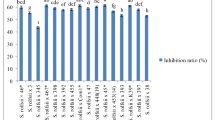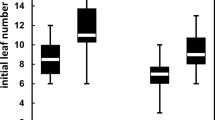Abstract
The mycoparasite Coniothyrium minitans, but not a commercial preparation of Trichoderma or a local isolate of Trichoderma virens, significantly increased the percentage of sclerotia infected and reduced the percentage viability of sclerotia when applied to lettuce plants showing the earliest symptoms of lettuce drop caused by Sclerotinia minor in commercial crops. C. minitans always infected untreated controls in these experiments and was evidently a natural resident in the soils; it is likely that it effects a degree of natural biocontrol of sclerotia of S. minor in these soils. In spring and summer, the viability of untreated sclerotia among plant debris on the surface of the soil declined greatly, providing evidence that prolonging the exposure of sclerotia on the soil surface before cultivation for the next crop can greatly reduce sclerotial inoculum. Far fewer sclerotia were formed on infected, untreated plants in late spring to summer than in autumn and early spring. Epidemics of lettuce drop caused by S. minor on salad lettuces developed rapidly in the last 1 or 2 weeks before harvest. This was as a result of infection mainly via the lower leaves drooping onto the surface of the soil or touching adjacent infected plants. Clumping of diseased plants was evident only late in the epidemic. Cutting of infected mature plants at an early stage of symptom development and leaving them in the field did not reduce the number of sclerotia formed on them compared to plants left in the ground, indicating that cut plants should be removed from the field. Possibilities for disease control are discussed.
Similar content being viewed by others
References
Abawi GS, Grogan RG (1979) Epidemiology of diseases caused by Sclerotinia species. Phytopathology 69, 899–904.
Abawi GS, Grogan RG, Duniway JM (1985) Effect of water potential on survival of sclerotia of Sclerotinia minor in two California soils. Phytopathology 75, 217–221.
Adams PB (1975) Factors affecting survival of Sclerotinia sclerotiorum in soil. Plant Disease Reporter 59, 599–603.
Adams PB, Ayers WA (1979) Ecology of Sclerotinia species. Phytopathology 69, 896–899.
Adams PB, Tate CJ (1975) Factors affecting lettuce drop caused by Sclerotinia sclerotiorum. Plant Disease Reporter 59, 140–143.
Anon. (2004) Sclerotinia booklet. Lettuce Leaf, No. 18. NSW Agriculture, Horticulture Australia, December 2004.
Ayers WA, Adams PB (1979) Mycoparasitism of sclerotia of Sclerotinia and Sclerotium species by Sporidesmium sclerotivorum. Canadian Journal of Microbiology 25, 17–23.
Budge SP, McQuilken MP, Fenlon JS, Whipps JM (1995) Use of Coniothyrium minitans and Gliocladium virens for biological control of Sclerotinia sclerotiorum in glasshouse lettuce. Biological Control 5, 513–522. doi: 10.1006/bcon.1995.1061
Burgess DR, Hepworth G (1996) Biocontrol of sclerotinia stem rot (Sclerotinia minor) in sunflower by seed treatment with Gliocladium virens. Plant Pathology 45, 583–592. doi: 10.1046/j.1365-3059.1996.d01-145.x
Dillard HR, Grogan RG (1985) Relationship between sclerotial spatial pattern and density of Sclerotinia minor and the incidence of lettuce drop. Phytopathology 75, 90–94.
Grogan RG, Sall MA, Punja ZK (1980) Concept of modeling root infection by soilborne fungi. Phytopathology 70, 361–363.
Hao JJ, Subbarao KV (2005) Comparative analysis of lettuce drop epidemics caused by Sclerotinia minor and S. sclerotiorum. Plant Disease 89, 717–725.
Hawthorne BT (1974) Sclerotinia minor on lettuce: effect of plant growth on susceptibility to infection. New Zealand Journal of Agricultural Research 17, 387–392.
Huang HC, Hoes JA (1980) Importance of plant spacing and sclerotial position to development of sclerotinia wilt of sunflower. Plant Disease 64, 81–84.
Imolehin ED, Grogan RG (1980) Factors affecting survival of sclerotia, and effects of inoculum density, relative position, and distance of sclerotia from the host on infection of lettuce by Sclerotinia minor. Phytopathology 70, 1162–1167.
Imolehin ED, Grogan RG, Duniway JM (1980) Effect of temperature and moisture tension on growth, sclerotial production, germination, and infection by Sclerotinia minor. Phytopathology 70, 1153–1157.
Isnaini M (1999) Studies of infection and control of Sclerotinia minor on lettuce and sunflower in Southern Australia. PhD Thesis, La Trobe University, Bundoora, Australia.
Isnaini M, Burgess DR, Keane PJ (1998) The use of cultures of Sclerotinia minor for selective isolation and enumeration of mycoparasitic isolates of Trichoderma from soil and roots. Australasian Plant Pathology 27, 244–250. doi: 10.1071/AP98027
Jarvis WR, Hawthorne BT (1972) Sclerotinia minor on lettuce: progress of an epidemic. The Annals of Applied Biology 70, 207–214.
Madden LV, Louie R, Abt JJ, Knoke JK (1982) Evaluation of tests for randomness of infected plants. Phytopathology 72, 195–198.
Marois JJ, Adams PB (1985) Frequency distribution analyses of lettuce drop caused by Sclerotinia minor. Phytopathology 75, 957–961.
Melzer MS, Boland GJ (1994) Epidemiology of lettuce drop caused by Sclerotinia minor. Canadian Journal of Plant Pathology 16, 170–176.
Merriman PR (1976) Survival of sclerotia of Sclerotinia sclerotiorum in soil. Soil Biology & Biochemistry 8, 385–389. doi: 10.1016/0038-0717(76)90038-9
Patterson CL, Grogan RG (1985) Differences in epidemiology and control of lettuce drop caused by Sclerotinia minor and S. sclerotiorum. Plant Disease 69, 766–770.
Sokal RR, Rohlf FJ (1981) ‘Biometry.’ 2nd edn. (W.H. Freeman & Co.: San Francisco, CA)
Subbarao KV (1998) Progress toward integrated management of lettuce drop. Plant Disease 82, 1068–1078.
Tribe HT (1957) On the parasitism of Sclerotinia sclerotiorum by Coniothyrium minitans. Transactions of the British Mycological Society 40, 489–499.
Trutmann P, Keane PJ, Merriman PR (1980) Reduction of sclerotial inoculum of Sclerotinia sclerotiorum with Coniothyrium minitans. Soil Biology & Biochemistry 12, 461–465. doi: 10.1016/0038-0717(80)90080-2
Wu BM, Subbarao KV (2003) Effects of irrigation and tillage on temporal and spatial dynamics of Sclerotinia minor sclerotia and lettuce drop incidence. Phytopathology 93, 1572–1580.
Author information
Authors and Affiliations
Corresponding author
Rights and permissions
About this article
Cite this article
Isnaini, M., Keane, P.J. Biocontrol and epidemiology of lettuce drop caused by Sclerotinia minor at Bacchus Marsh, Victoria. Australasian Plant Pathology 36, 295–304 (2007). https://doi.org/10.1071/AP07024
Received:
Accepted:
Issue Date:
DOI: https://doi.org/10.1071/AP07024




